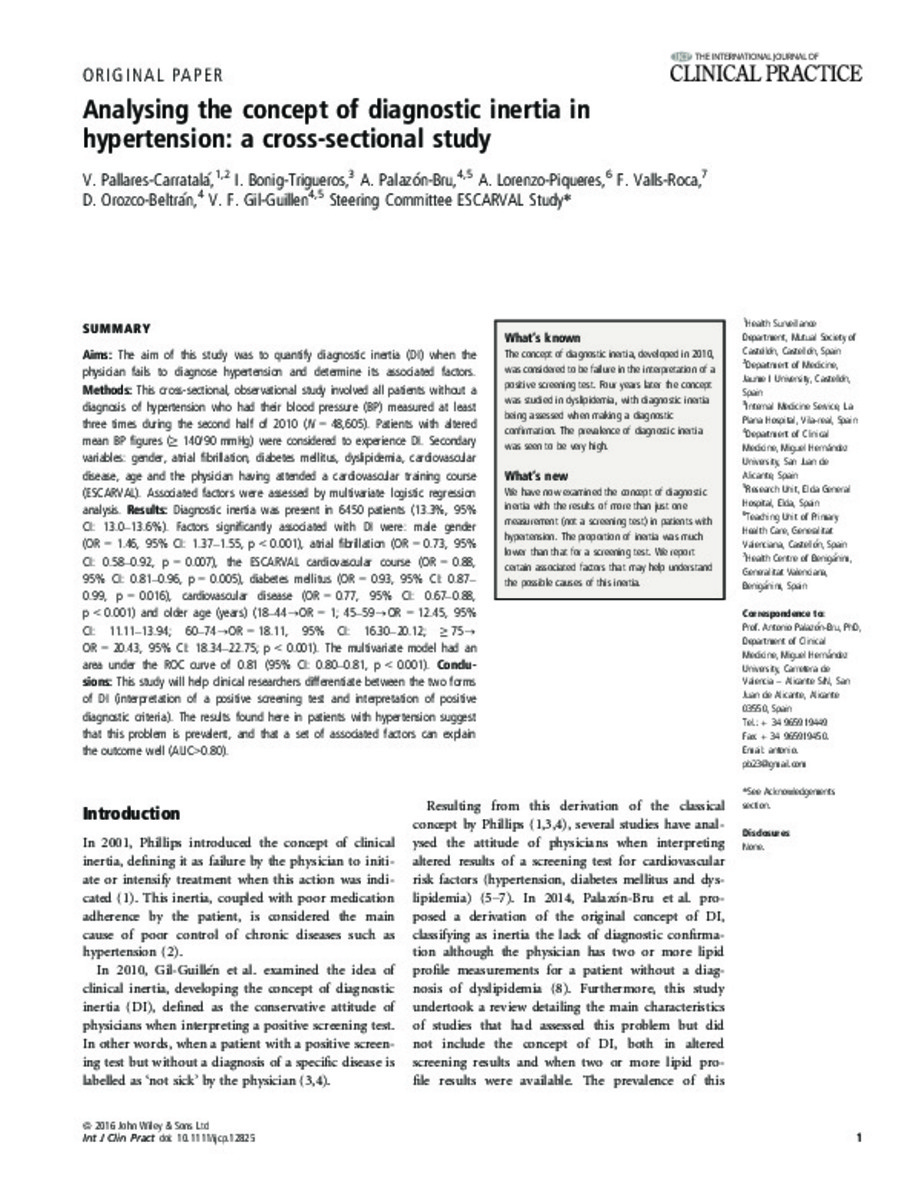Mostrar el registro sencillo del ítem
Analysing the concept of diagnostic inertia in hypertension: a cross-sectional study
| dc.contributor.author | Pallarés-Carratalá, Vicente | |
| dc.contributor.author | Bonig-Trigueros, Irene | |
| dc.contributor.author | Palazón-Bru, Antonio | |
| dc.contributor.author | Lorenzo-Piqueres, A. | |
| dc.contributor.author | Valls Roca, Francisco | |
| dc.contributor.author | Orozco Beltrán, Domingo | |
| dc.contributor.author | Gil-Guillén, Vicente F | |
| dc.date.accessioned | 2016-07-06T14:59:22Z | |
| dc.date.available | 2016-07-06T14:59:22Z | |
| dc.date.issued | 2016 | |
| dc.identifier.citation | Pallares-Carratalá, V., Bonig-Trigueros, I., Palazón-Bru, A., Lorenzo-Piqueres, A., Valls-Roca, F., Orozco-Beltrán, D., Gil-Guillen, V. F., Steering Committee ESCARVAL Study (2016), Analysing the concept of diagnostic inertia in hypertension: a cross-sectional study. International Journal of Clinical Practice, 70: 619–624. doi: 10.1111/ijcp.12825 | |
| dc.identifier.uri | http://hdl.handle.net/10234/161541 | |
| dc.description.abstract | Aims The aim of this study was to quantify diagnostic inertia (DI) when the physician fails to diagnose hypertension and determine its associated factors. Methods This cross-sectional, observational study involved all patients without a diagnosis of hypertension who had their blood pressure (BP) measured at least three times during the second half of 2010 (N = 48,605). Patients with altered mean BP figures (≥ 140/90 mmHg) were considered to experience DI. Secondary variables: gender, atrial fibrillation, diabetes mellitus, dyslipidemia, cardiovascular disease, age and the physician having attended a cardiovascular training course (ESCARVAL). Associated factors were assessed by multivariate logistic regression analysis. Results Diagnostic inertia was present in 6450 patients (13.3%, 95% CI: 13.0–13.6%). Factors significantly associated with DI were: male gender (OR = 1.46, 95% CI: 1.37–1.55, p < 0.001), atrial fibrillation (OR = 0.73, 95% CI: 0.58–0.92, p = 0.007), the ESCARVAL cardiovascular course (OR = 0.88, 95% CI: 0.81–0.96, p = 0.005), diabetes mellitus (OR = 0.93, 95% CI: 0.87–0.99, p = 0.016), cardiovascular disease (OR = 0.77, 95% CI: 0.67–0.88, p < 0.001) and older age (years) (18–44[RIGHTWARDS ARROW]OR = 1; 45–59[RIGHTWARDS ARROW]OR = 12.45, 95% CI: 11.11–13.94; 60–74[RIGHTWARDS ARROW]OR = 18.11, 95% CI: 16.30–20.12; ≥ 75[RIGHTWARDS ARROW]OR = 20.43, 95% CI: 18.34–22.75; p < 0.001). The multivariate model had an area under the ROC curve of 0.81 (95% CI: 0.80–0.81, p < 0.001). Conclusions This study will help clinical researchers differentiate between the two forms of DI (interpretation of a positive screening test and interpretation of positive diagnostic criteria). The results found here in patients with hypertension suggest that this problem is prevalent, and that a set of associated factors can explain the outcome well (AUC>0.80). | ca_CA |
| dc.format.extent | 6 p. | ca_CA |
| dc.format.mimetype | application/pdf | ca_CA |
| dc.language.iso | eng | ca_CA |
| dc.publisher | Wiley | ca_CA |
| dc.relation.isPartOf | International Journal of Clinical Practice Volume 70, Issue 7, pages 619–624, July 2016 | ca_CA |
| dc.rights | "This is the peer reviewed version of the following article: Pallares-Carratalá, V., Bonig-Trigueros, I., Palazón-Bru, A., Lorenzo-Piqueres, A., Valls-Roca, F., Orozco-Beltrán, D., Gil-Guillen, V. F., Steering Committee ESCARVAL Study (2016), Analysing the concept of diagnostic inertia in hypertension: a cross-sectional study. International Journal of Clinical Practice, 70: 619–624. doi: 10.1111/ijcp.12825, which has been published in final form at http://dx.doi.org/10.1111/ijcp.12825. This article may be used for non commercial purposes in accordance with Wiley Terms and Conditions for Self-Archiving." © 2016 John Wiley & Sons Ltd | ca_CA |
| dc.rights.uri | http://rightsstatements.org/vocab/InC/1.0/ | * |
| dc.title | Analysing the concept of diagnostic inertia in hypertension: a cross-sectional study | ca_CA |
| dc.type | info:eu-repo/semantics/article | ca_CA |
| dc.identifier.doi | http://dx.doi.org/10.1111/ijcp.12825 | |
| dc.rights.accessRights | info:eu-repo/semantics/openAccess | ca_CA |
| dc.relation.publisherVersion | http://onlinelibrary.wiley.com/doi/10.1111/ijcp.12825/abstract | ca_CA |
Ficheros en el ítem
Este ítem aparece en la(s) siguiente(s) colección(ones)
-
MED_Articles [640]
Articles de publicacions periòdiques







